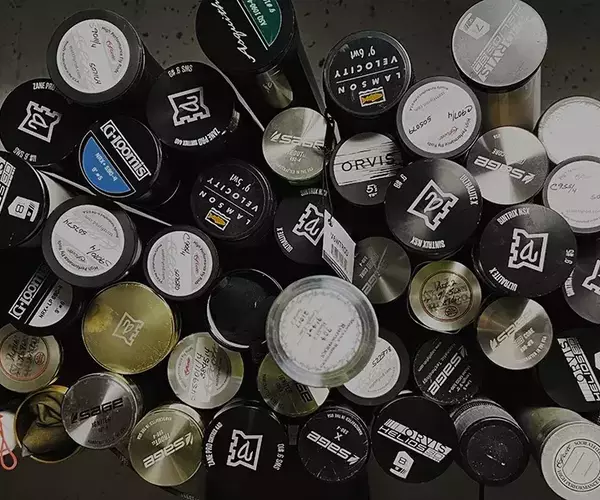
Montana Fly Fishing Rods: The Essential Picks
Modern fly rods are lightweight, durable, and more versatile than ever before. All major fly rod manufacturers have adopted technology to improve their design process, graphite materials, and manufacturing processing. Today, anglers can expect real, added value in high-end fly rods than ever.
Premium fly rods are lightweight, sensitive, and load quickly during the casting stroke. This translates to more time spent fly fishing with flies in the water rather than in a tangled mess wrapped around the anglers’ rod tip.
The most noticeable difference between premium and lower price-point rods lies in the materials used in the rod blanks and premium components. Sophisticated resins add durability while reducing overall weight.
The Importance of a Quality Fly Rod
No, you don’t need a $1000 fly rod – but they sure are nice! As fly fishing guides, we spend a lot of time with beginner and novice anglers. In the two decades plus of guiding Montana fly fishing trips, we have noticed that nothing simplifies teaching the basics of casting more than a quality fly rod.
Choosing Your First Fly Rod: The Versatile 5-Weight
In general, fly rod design has evolved to the point where each model is purpose-built. A nine-foot, 5-weight (905 or 590 size designation) is the benchmark model used for most trout fly fishing. This versatile fly rod model works great when fly fishing with dry flies, nymphs, and small streamers.
The St. Croix Evos 590, Sage R8 CORE 590, Scott Centric 905, Hardy Ultralight X 905, and G. Loomis NRX+ 590 are our top picks for all-around premium fly rods.
The Lamson Radius 905 and Sage Foundation 590 are all great mid-range choices. Price-conscious anglers should consider the St. Croix Connect or Orvis Clearwater series of fly rods in the entry-level range.
Adding to Your Arsenal: The 6-Weight for Windy Conditions
Here in Montana, fly fishing often takes place in windy conditions on relatively large rivers in wide open spaces. Anglers fishing in Montana use more large flies than many trout fishing destinations in the West, so a secondary fly rod choice in a six-weight is ideal.
Fly fishing with heavy indicator nymph rigs, streamers, and even large dries in the wind is easier with a six weight. The downside to the 6 is that it’s a bit heavy for technical dry fly and nymphing scenarios. However, a good six-weight nicely compliments a versatile 5-weight fly rod in situational fly fishing during windy conditions or when using heavy flies.
The Sage IGNITER 690 or G. Loomis NRX+ 690 are a couple of our Montana fishing guide’s top picks for premium six weights. Some of us prefer models with a fighting butt as this adds leverage when mending heavy rigs or fighting big fish. Check out the Lamson Velocity 906 or Sage Foundation 690 if the high-end rods are out of your price range. The Redington Vice or ECHO BOOST (fresh) are a pair of entry-level models worth considering as well.
Presentation Matters: The Delicate Art of the 4-Weight
Slow-sipping trout feeding on Trico spinner or PMD cripples call for delicate yet accurate presentations when fly fishing in Montana on spring creeks and technical tailwater fisheries like the Missouri or Bighorn Rivers. These situational scenarios are right in the “wheelhouse” of that all-around nine foot 5-weight, but these are the times when a slightly “slower” and lighter rod really shines.
The slow or softer action of a “presentation” fly rod enables skilled casters to accurately deliver delicate presentations of small dry flies and nymphs while using long leaders. Fine tippets typically go hand-in-hand with long leaders and the softer tips on this style of fly rod help reduce break offs during explosive runs by feeding trout.
The St. Croix Technica 489 and Scott GS 886 are two favorite presentation fly rods that our fly fishing guides prefer for technical dry fly fishing. Terrific for “match the hatch” dry fly fishing on Montana’s big river, these rods are also a blast to fly fish with on small streams and spring creeks where fish sizes tend to be smaller than those found in the mainstem waterways.
Solid mid-range presentation fly rods are harder to find than all-around or fast-action models as overall consumer demand is much lighter. The G. Loomis IMX-PRO Creek 794 or Sage SONIC 486 are both worthy choices for anglers looking to add more versatility to their fly rod quiver when fly fishing in Montana. Consider a Redington Butterstick 476 fiberglass fly rod as a fun, price-point alternative presentation-style rod.
Matching Your Rod to Your Fishing Style
Montana fly fishing is diverse, and one fly rod just doesn’t cover an angler’s needs in all ofwe encounter on a typical day on the water. There are dozens of models and brands to choose from; we recommend starting with a nine-foot-5-weight and then adding a heavier or lighter model based on the type of fly fishing you most prefer. If you like fishing little dries, the situations then you will want to go lighter, but if streamer fly fishing is your thing, then add a stout 6-weight next.
Fins and Feathers Guide Service has been outfitting Montana fly fishing trips for over two decades. We owned and operated “Fins and Feathers of Bozeman,” which was one of the region’s largest retail fly shops for 23 years. Although we sold the original Bozeman fly shop to the travel agency known as Yellow Dog, we continue to be actively involved in the fly fishing industry.
We know fly rods, so feel free to lean on our expertise when making your first or next fly rod purchase for an unbiased recommendation whether you are looking for a new rod for Trout or Tarpon, we have the expertise to help simplify the process for you.
Fly Rod Use Included on our Montana Fly Fishing Trips
During our guided Montana fly fishing trips, fly rods are provided for free. You do not need to bring your own, but we recommend bringing your own if you have them!
If you bring your own, we suggest a nine-foot 5 or 6 weight as your primary fly rod. Guests are welcome to bring up to 2 assembled fly rods with them in the boats; we can accommodate more as long as they are in their travel tubes when not in use. If you aren’t sure which ones to bring, just reach out, and we will offer our opinion based on the time of year and expected conditions.
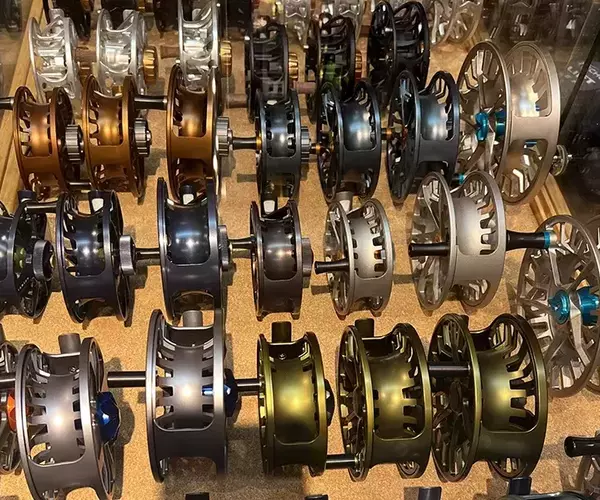
Choosing the Perfect Fly Reel for Montana Fly Fishing
Fly reels are modern-day engineering marvels made possible by machining and material advancements. Some anglers might argue that a reel is just a fly line holder, but we believe that a reel is an essential piece of any angler’s fly fishing kit.
A machined aluminum reel is the most durable and lightest option.Compare the balanced feel of a machined large arbor reel like a Ross Evolution FS or Hatch Iconic to an inexpensive cast reel, and you will quickly appreciate the difference.
Drag systems are similar across brands but employ proprietary design nuances or materials to differentiate themselves. A quality reel will add enjoyment to your angling experience.
Top-Tier Reels: Built to Last
Hatch Iconic fly reels are as good as it gets. Their durability ensures a lifetime of use, even for those who are hard on their gear. The casual angler can expect a lifetime of use from a Hatch fly fishing reel.
There is no shortage of premium, reliable fly reels available today. Anglers fishing near Bozeman should prioritize reels machined from aircraft-grade aluminum with an adjustable drag system consisting of a series of stacked plates or conical drag surfaces for optimal performance.
The Ross Evolution FS, Abel SDF, and Sage Spectrum LT are a few more high-performance freshwater reel choices that are ideal for fly fishing in Montana.
Mid-Range Options: Reliable Performance
The Ross Animas and Lamson GURU S are mid-range fly reels that perform well and withstand heavy use.
We recommend avoiding cast aluminum or machined “composite” (plastic) reels altogether, as these often use sub-par interior components that won’t last long with heavy use.
Fly Reel Use Included on our Montana Fly Fishing Trips
Fly reels are included on our guided fly fishing trips in Montana and are paired with an appropriate fly rod for a balanced feel. Guests are welcome to bring their own reel, especially if they use a right-hand retrieve (left-handed caster). We can provide right-hand retrieve reels upon request, but feel free to bring your own if you have one you prefer.
With 25 years of experience in the fly fishing industry, fly fishing travel, and guiding fly fishing trips in Montana, we are uniquely qualified (and unbiased) to help our guests find the perfect fly fishing gear. Reach out to us or talk with your guide for fly reel recommendations for fly fishing in Montana and beyond.
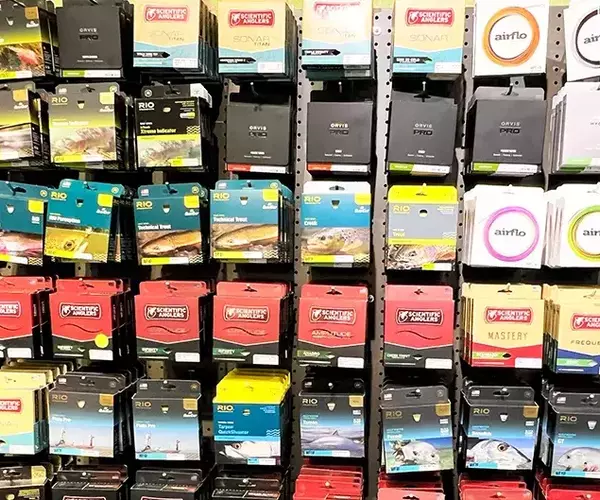
Fly Lines for Fly Fishing in Montana: Choosing the Right One
Fly lines are surprisingly complicated and come in myriad, purpose-built configurations. Although application-specific lines work wonders in the hands of advanced anglers, they often hinder novice anglers.
A floating fly line with a “weight-forward” taper is the typical starting point for an all-around line choice when fly fishing in Montana. Sinking fly lines are essential tools for the streamer angler and are available in a wide range of configurations and densities.
Application-specific fly lines are engineered to perform certain tasks really well. Delicate presentations, casting heavy nymph rigs, and casting large dries from a drift boat in the wind are easier and more efficient with the proper line.
Anatomy of a Fly Line: Weight, Length, and Matching to Your Rod
The overall length of most freshwater fly lines is 90’ with a 30’ section that is called the “head.” The head section is what is used to determine the weight of a fly line which is based on a range of grain weights. Grain weight is usually not advertised on fly-line packaging but it is generally around 140 grains for a 5-weight. The head on a six weight line is typically around 160 grains.
Fly rod manufacturers design their rods to perform optimally with a designated line weight, meaning that a 5-weight rod is designed to cast a 5-weight line. It’s not uncommon for a rod to be able to cast a heavier line just fine, or even better, than its designated line size, but that is often related to the skills of the caster as much as it is to the design of the fly rod. A heavier line slows down a fast-action fly rod, enabling the caster to feel the load-point during the casting stroke better.
Popular Fly Line Choices for Montana Fly Fishing
The RIO Gold is a wonderful, all-around fly line taper that works great for all types of fly fishing in Montana. We prefer the Elite Rio Gold as it is built on a low-stretch core and features advanced slickness coatings for exceptional castability.
If you like textured fly lines, the Scientific Angler’s Amplitude in an Infinity taper is a great choice for fast-action fly rods. The Rio Elite Technical Trout is designed for the presentation dry fly angler with a long front taper to help deliver flies with delicate accuracy.
The Rio Elite Extreme Indicator line is awesome on a dedicated indicator-nymphing setup. The heavy head floats exceptionally well and turns over heavy indicator rigs with ease.
Sink-Tip Lines for Streamer Fishing
Streamer fly fishing often involves using fly lines that sink—either completely or just in the tip section. When anglers are floating and fly fishing (like we primarily do in Montana), a fly line with a floating running line and a sinking tip section is ideal.
These fly lines come in many different configurations, each designed with a particular scenario in mind. The RIO Elite Predator fly line tape is available in several different sink rates, we prefer the F/I/S or F/M/S when fly fishing Montana rivers.
Fly Line Use Included on our Montana Fly Fishing Trips
Our guided fly fishing trips in Montana include the use of paired fly lines. Our fly fishing guides typically have setups ready to go with floating lines on them, as that covers 90% of our fly-fishing needs. Sink-tip fly lines are occasionally used when streamer fly fishing on our guided trips; the guides will provide them when needed.

Montana Fly Fishing: Dressing for Success in Unpredictable Weather
Montana weather is wildly unpredictable, with extreme temperature ranges commonplace in the summer months. Visitors aren’t so surprised by the cold mornings in the spring and fall, but they are often shocked when they step out of their guide’s truck at the boat ramp and into 45-degree air.
Being comfortable is key to success in fly fishing, so be prepared with well-designed and functional apparel.
Layer up - regardless of the season - and invest in quality performance gear and apparel. Technical fabrics protect from harmful UV Rays, move moisture away from your skin in the cold, and are designed with active anglers in mind.
Invest in quality rain gear that will actually keep you dry when it matters most!
Essential Fly Fishing Accessories: Sun Protection and Comfort
Accessories such as hats, sun masks, gloves, and raincoats should be included in every angler’s kit when fly fishing in Montana. Whether you are fly fishing Montana for a day or a month, these elements are essential for sun protection and warding off afternoon thunderstorms. Think beanies and fleece gloves for the shoulder season and sungloves and baseball caps for the summer season.
Breathable Clothing is Key: Tops and Pants
Tops that are made of quick-drying and breathable polyester, nylon, or blends are incredibly comfortable and offer sun protection during long summer days. Our guides opt for tops with built in hoods and long sleeves like the Skwala Fly Fishing Sol Collection.
Quick-drying, lightweight pants protect the angler from the sun and biting insects like feer flies. Avoid cotton sweatpants and blue jeans as these become uncomfortable if they get wet and are too hot once the day warms up. Anglers fishing out of drift boats rarely need to worry about getting wet, but it’s nice to have pants that are lightweight and dry quickly, allowing for the flexibility of adding a bit of wet-wading to the typical day of fishing.
The Art of Layering: Staying Comfortable All Season
Layering is the key to comfort while fly fishing in Montana, regardless of the season. Base layer tops and bottoms like the Patagonia Capilene collection work well in the colder months. A wool-based mid-layer like the Skwala Thermo Collection is ideal under waders on frosty spring and fall mornings.
An insulated jacket like the Patagonia Nano Puff or Skwala Fusion Hybrid is great for summer mornings and as winter insulation under a waterproof/breathable outer layer.
The Skwala RS and Carbon Jackets are our guide’s go-to choices for rugged outerwear demands when conditions turn south, midday. These waterproof and breathable jackets block the wind and rain, enabling anglers to keep fishing through a summer squall. Pair the top with high-quality rain pants from Skwala or Patagonia for all-day comfort while floating and fishing through the wet spring and early summer months.
Fins and Feathers Guide Service: Your Montana Fly Fishing Experts
Our guided fly fishing trips in Montana do not include apparel or clothing accessories like hats, sunglasses, socks, etc. Use of fly fishing gear like rods, reels, flies, and terminal tackle are included. We provide waders and wading boots when we expect to spend time wading during the spring and fall months. Guests are expected to bring their own apparel, including raingear.

Montana Fly Fishing Waders: When to Wear Them and What to Look For
Comfort on the water tends to facilitate success! A great pair of waterproof and breathable chest waders are essential elements of every angler’s fly fishing kit. While waders aren't used often in Montana during the summer months, we still rely on them during the shoulder and winter seasons (3/4 of the year).
Wader technology today is light years ahead of where it was just 10 years ago. Whether the waterproof/breathable membrane is an applied or fabric (Gore-Tex) layer, today’s waders by Skwala, Simms, Patagonia, and Orvis are incredibly comfortable in both warm and cold weather. The real difference comes down to fit and features.
If you are going to be wearing waders often, then spring for the bells and whistles, such as convertible tops, zipper chests, hand-warming pockets, interior pockets, anatomically correct booties, integrated back support, etc.
Top Wader Choices for Frequent Use
These days, the Skwala Carbon and RS Waders are our favorite men's waders. The Patagonia Swiftcurrent Expedition Zip Waders for women are terrific for lady anglers who spend a lot of time on the water and in waders.
Finding the Right Waders for Your Needs
For anglers who wear their waders less than 20 days a year, any of the styles by the leading brands will do the trick. Just keep in mind that the low-end selections will have barebone features, minimal fabric layers, and dated waterproof barrier technology. This is fine for most folks, but anglers will sacrifice long-term durability and immediate comfort features.
Waders Included on our Montana Fly Fishing Trips
We include the use of waders and wading boots on our guided fly fishing trips in Montana during the spring and fall seasons when needed. We will occasionally use them in the summertime during cold spells or rainy days. However, we generally do not wear them on day trips as there is very little need for them between June and September.
If you have your own breathable waders and would like to wear them, bring them. They will be far more comfortable than our rental waders and boots!
The high-water season runs from May through mid-June, and water levels are too high to wade most years until early July. Water temperatures reach into the 60s by early June, making wet wading the more comfortable option by late June.
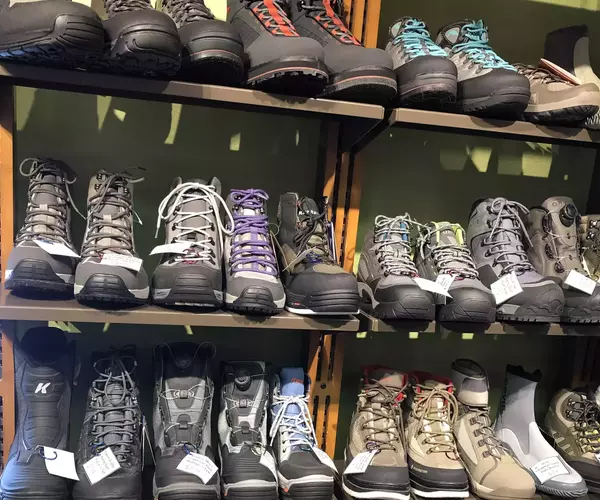
Montana Fly Fishing Footwear: Waders, Boots, and Summer Options
Wade fishing in Montana is much more challenging than most first-time visitors expect. Walking around the upper Madison is like trying to walk on top of bowling balls coated with Crisco!
There are many reasons why Montana fly fishing guide trips use drift boats and rafts to fly fish Montana’s blue-ribbon trout rivers, but none is more significant than the reality that it is hard to walk around these rivers!
Great wading boots are essential for safety and mobility when wade-fishing Montana. Rubber soles have come a long way in terms of traction and also reduce the transmission of AIS across river drainages. Anglers can add metal screws or studs to the soles for added traction when needed and remove them for use in boats or rafts.
Top Wading Boot Choices
The Vibram-soled Patagonia Foot Tractor boots made in the USA by Danner are top-shelf boots built to last and perform like nothing else in every wading situation. The Simms Flyweight wading boots with Vibram soles are nice, light-duty boots perfect for summertime use with or without waders.
Wet Wading: The Summertime Mainstay
Wet wading is the mainstay for anglers fishing in Montana from June through most of September. Neoprene booties are essential for all-day comfort when wet wading as they provide a layer of protection that reduces chaffing and adds much-needed cushion when walking across rocky river bottoms.
Footwear for Summer Float Trips
Sandals, wet-wading shoes, or even flip-flops are perfect for those summer float trips while fly fishing in Montana. The river water is refreshing on the feet during a mid-July outing. Teva and OOFOS make really comfortable sandals and flip-flops that are great for use during the summertime. The Orvis PRO Approach shoe provides enhanced traction in a comfortable water shoe design.
Anglers getting in and out of boats will find that simple footwear is much more comfortable and convenient than bulky wading boots when floating and fly fishing. The wet wading scenarios during the summertime typically involve stealthy bankside approaches rather than wading around in knee-deep water, so opt for comfort whenever possible.
Footwear on Our Guided Montana Fly Fishing Trips
Wading boots are provided on our guided fly fishing trips in Montana when waders are advised. They are also available on wading trips guided fly fish, but guests are responsible for providing their own wet-wading socks or neoprene booties.
On the vast majority of our guided fly fishing trips, waders or wading boots are not needed. Guests are encouraged to bring comfortable footwear, like sandals or shoes, that can handle a little water when getting in and out of the boats. Street shoes are acceptable, but they will limit where and when anglers can access the riverbank.
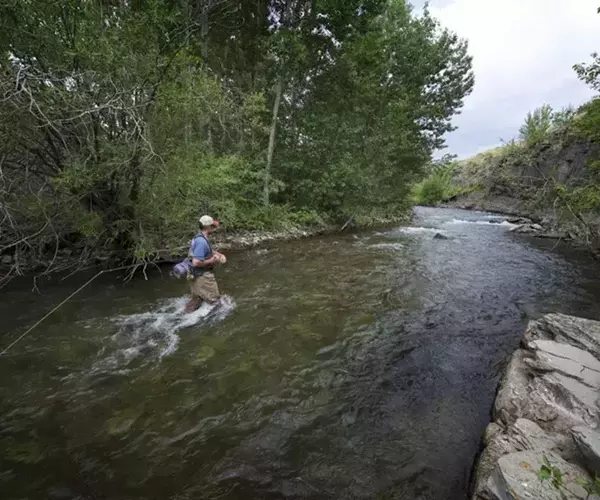
Montana Fly Fishing: Choosing the Right Pack for Your Needs
Fly fishing requires a lot of “stuff’, accessories like nippers, knot-tying tools, fly floatant, strike indicators, split-shot, tippet rings, fly boxes, pliers, hemostats, and the list goes on.
All of these are small essentials and anglers eventually have to figure out how to carry them all, whether in a boat for floating or a pack for wading.
While boat bags are practical for fly fishing guides and driftboat owners, they aren't very practical for the wading angler. Backpacks can be configured for a variety of types of outings, but they can be too bulky for a quick outing to your favorite stream or lake. Slingpacks, fanny packs, chest packs, and simple lanyards all have their place - start with something versatile and then look for alternatives as your interests broaden.
Boat Bags: Keeping Your Gear Organized While Floating
When floating and fly fishing in Montana, a purpose-built boat bag like the Patagonia Great Divide or Fishpond Cutbank offers waterproof protection and internal organization systems. Ideally-sized to fit in a drift boat or raft, Montana fly fishing guides consider these to be their “briefcases.”
Wading Packs: Choosing the Right Fit and Style
Wading anglers fishing in Montana can choose from sling packs, hip packs, backpacks, chest packs, or systems that incorporate multiple packs. Always try a few different styles on as fit for any of these styles varies from one person to the next.
Sling Packs: Easy Access and Mobility
Sling packs are modern-day bandoleers with a small strap and pack worn diagonally across the torso. Many anglers prefer sling packs as they stow gear on their backs, freeing up their chests and sides for casting. Simply slide the pack around to the front to access gear and accessories. The Fishpond Summit Sling and Umpqua Northfork Sling are two of our guide’s top picks in this category of fly fishing pack.
Chest and Hip Packs: Ideal for Quick Trips
Chest and hip packs have less capacity than a sling or backpack, making them ideal for quick outings or days spent on familiar waters. We prefer a waterproof hip pack as deep wading invariably catches every angler off-guard more often than not. The Patagonia Guidewater Hip Pack has been a time-tested solution for our guides in both fresh and saltwater fly fishing.
Chest packs should be simple, small, and have a “clean” design. Loose straps and excess zipper pulls are a real nuisance with chest packs as they constantly catch loose fly lines while casting. The Fishpond San Juan Vertical Pack is popular with our Montana fly fishing guides for quick outings.
Backpacks: Versatility for Long Days
Backpacks are versatile in design, making them ideal for long days outside on the water, in the field, or for commuting to work back home. Fly fishing packs are purpose-built with the angler in mind, so expect lots of pockets designed with quick access in mind, net attachments, and sophisticated weight distribution straps for carrying heavy loads on long day hikes.
Our fly fishing guides opt for waterproof backpacks as we often carry cameras and spare clothes in wet conditions.
The Patagonia Guidewater Backpack has traveled the world with us on fly-fishing adventures. The Fishpond Firehole Backpack is a well-organized fly fishing pack that is equally at home on the water as in the office.
What Pack to Bring on Your Guided Fly Fishing Trip
Anglers fishing with Fins and Feathers Guide Service on a guided trip are welcome to bring a small pack or bag with them in the boat or raft. Waterproof, dry bags are not necessary but helpful on rainy days in the spring and fall. Guests are welcome to stow their basics in dry storage compartments found in both fly fishing rafts and boats. A small tote bag or backpack is ideal for carrying essentials and stowage in the boats.
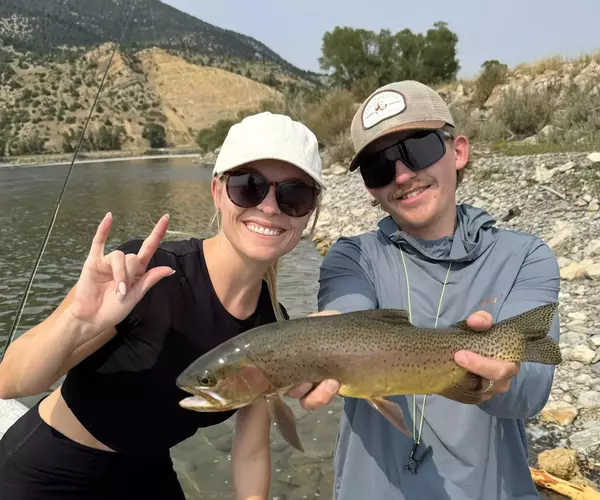
Essential Gear: Polarized Sunglasses for Fly Fishing
Polarized sunglasses are a must-have for fly fishing in Montana. They cut through surface glare, enabling anglers to see fish and underwater structures more clearly. This reduces spooking fish and helps the angler make accurate casts.
Additionally, sunglasses are an essential piece of safety equipment! Even the best casters occasionally end up with flies in their hats and fly lines wrapped around their heads on windy days, casting heavy flies.
Plastic or polycarbonate lenses are more impact-resistant than glass, but the optical clarity of glass just can't be matched.
Choosing the Right Lenses
- Glass vs. Polycarbonate: Glass lenses offer superior optical clarity and scratch resistance, but they are heavier and more expensive. Polycarbonate lenses are lighter, impact-resistant, and more affordable, but they can scratch more easily.
- Lens Color: For shallow-water fisheries like Montana's, amber, brown, or copper base tints provide the best contrast in varying light conditions. Darker lenses are better suited for bright sunlight and high-contrast situations in open water.
Fit and Style
- Comfort is Key: The most important factor is finding sunglasses that fit your face comfortably and securely. Try on several pairs before buying to ensure a good fit that won't slip during casting or wading.
- Popular Brands: Costa and Smith are well-established brands offering high-quality polarized sunglasses. Bajio is our preferred brand, they use plant-based materials in their frames and offer a variety of styles and lens colors for the eco-conscious angler.
- Budget-Friendly Choice: Suncloud provides a good selection of affordable, polarized sunglasses with plastic lenses. These are a great option for price-conscious anglers fishing freshwater.
Polarized Sunglasses on Guided Trips
Polarized sunglasses are considered essential gear for guided fly fishing trips in Montana. If you forget or don't have a pair, your guide can arrange a stop at a local fly shop where you can purchase some.
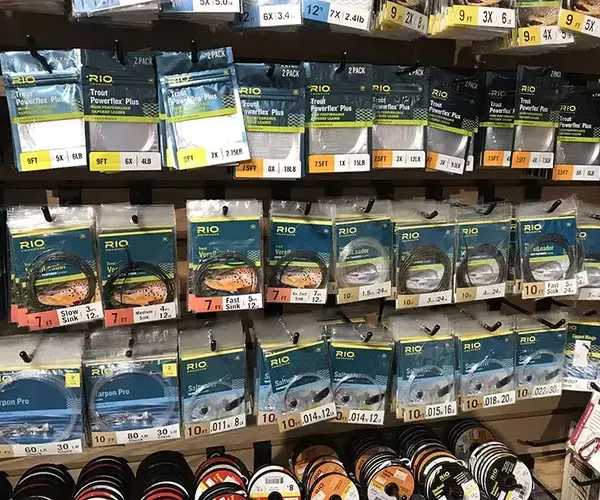
Montana Fly Fishing: Essential Tools and Terminal Tackle
There is no shortage of gadgets and accessories available for the fly angler today. While they all have a place and purpose, most of them end up sitting in a box somewhere far away from the fly fishing kit after a season or two!
Focus on the essentials like a good pair of hemostats, nippers, premium leader/tippet material and the necessary terminal tackle items.
Knot-tying tools, stream thermometers, and hook sharpeners are worth having but are used sparingly by most anglers.
Hemostats, Nippers, and More: Taking Care of Your Gear and Catch
Tools like hemostats for hook removal and nippers for trimming knots or cutting tippets should be among the first purchases every angler makes. Avid fly fishers typically have several pairs of each, stashed in pockets, boat bags, truck compartments, and cup holders in their boats. Additional tools like barb-crushing pliers, nail-knot tools, hook files, thermometers, tippet holders, fly patches, and zingers are valuable additions to any fly fisher's kit.
Wading Staffs and Landing Nets: Tools for Success
Adjustable wading staffs that fold up into several pieces for easy stowage in a hip holster are worthwhile for anglers fly fishing in Montana, primarily on foot.
Small nets that have rubber nets help minimize the harm to fish and aid with landing larger trout. Various accessories enable anglers to quickly attach and detach these nets from their packs or vests, we recommend the versions with a leash and magnet setup. Anglers fishing while floating in Montana will want a boat net with a large opening and long handle. Boat nets are essential when floating while small landing nets for wading are more of a convenience than a necessity.
Terminal Tackle: Connecting You to the Fish
Terminal tackle includes all the essential elements for fly fishing that ultimately connect anglers and fish. Whether you prefer fly fishing with nymphs, dries, or streamers, you'll likely accumulate dozens of each that will all need a variety of fly boxes to keep them organized and in good condition.
Essential Nymphing Supplies
Split shot, strike indicators, micro-swivels, and tippet rings are nymph-fishing essentials. Some anglers even add tungsten putty or treat their nymphs with sinking agents to get their flies down even quicker.
Keeping Dry Flies Afloat: Selection and Care
The dry fly angler covet premium fly floatants as these keep dry flies floating for maximum visibility and effectiveness. Gel-based floatants like Gink or Aquel are versatile and familiar options. For finicky trout on spring creeks and still waters, CDC-based dry flies are popular. Use Tiemco Dry Magic to keep them floating high on the surface.. Liquid floatants like Tiemco Dry Shake Liquid or Fly-Agra work best on big flies like Chubby Chernobyls, Slamonfly dries, and hopper patterns. Regardless of the liquid or gel-based floatant that the angler prefers, a desiccant powder like Loon's Top Ride is essential to quickly dry a fly after heavy use or landing a fish.
Leaders and Tippet Material: Making the Perfect Connection
Leader and tippet material connects the anglers’ flies to the fly line. Fly fishing leaders are tapered over their length, narrowing in diameter from the section that attaches to the fly line to the tippet section, which is tied to the fly. The taper ensures smooth energy transfer from the fly line, allowing for accurate presentations with dry flies and nymphs, and enables anglers to make accurate fly presentations when fly fishing with dry flies and nymphs. Tippet material is used to add length to the leader following multiple fly changes and the inevitable reality of tangles following a poorly executed cast.
Nylon leader and tippet material are suitable for a wide range of Montana fly fishing situations. They are preferred by dry fly anglers and commonly used for all types of fly fishing in off-color water conditions. RIO PPOWERFLEX is the staple nylon leader and tippet material in our guides' boat bags. Fluorocarbon tippet like RIO FLUORFLEX STRONG is highly abrasion resistant and less visible in the water, so it is preferred by advanced anglers for technical nymph-fishing in clear water.
What's Included on Our Guided Montana Fly Fishing Trip
Our guided fly fishing trips in Montana include the use of all terminal tackle. Our guides are well-supplied with everything from floatant to flies. Anglers are welcome to bring their own terminal tackle and flies, but fly fishing guides tend to have confidence in the fly patterns and terminal tackle that they prefer based on their years of experience.
As you begin to get “geared up” for your Montana fly fishing vacation, feel free to reach out to us via e-mail or through our contact form for help with making gear selections. We have over two decades of experience in the fly fishing industry and know the gear as well as we do our Montana home waters.
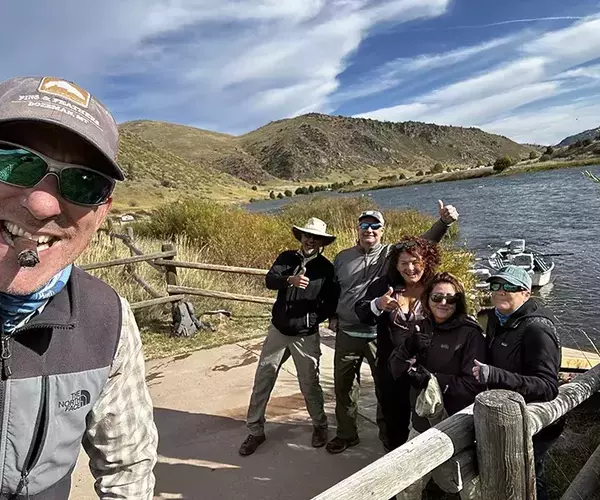
What's Included on Our Guided Montana Fly Fishing Trip?
All of our guided fly fishing trips include complimentary use of fly rods, reels (with lines), and terminal tackle.
Waders and boots are provided during periods of inclement weather and wade fishing trips during the spring and fall. Although this is all provided, we encourage anglers to bring and use their gear if it’s appropriate for our style of fly fishing.
With over two decades of experience in the fly fishing industry in both retail and outfitting Montana fly fishing trips, the team at Fins and Feathers has the expertise to help with all of your angling and gear needs. Please reach out to us for help or questions about any of your fly fishing needs,
Review our packing list for help with preparing for your guided fly fishing trip with our Bozeman fly fishing guides.
Related Articles From The Montana Fly Fishing Blog

Category: Gear Reviews
Essential Skwala Fishing Gear for Cold Weather
Post Date: 11/07/2024
The change in seasons has anglers fishing near Bozeman, Montana swapping out the old reliable summer essentials for the comfort and warmth of guide-tested baselayers and outerwear from Skwala Fishing....
Read Article









